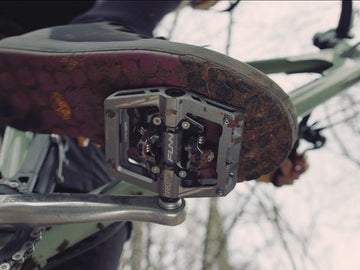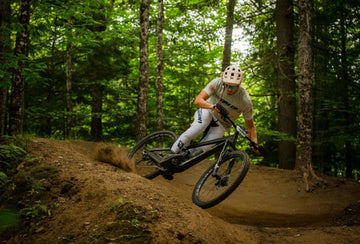Flat vs Clipless Pedals
Mountain biking is an adrenaline-pumping sport that demands careful thought and selection of its numerous components. At the heart of these, the pedals play a significant role. They serve as the critical interface between the rider and the bike. The design of flat vs clipless pedals greatly impacts the overall riding experience.
In this exhaustive guide, we aim to explore the multifaceted world of mountain bike pedals. We’ll provide an in-depth comparison of flat vs clipless pedals. We will discuss the pros and cons of each pedal type, supplement our discussion with insights from biking experts, and recommend specific models for consideration.
Whether you’re a seasoned biker aiming to maximize your performance, or a newcomer wanting to make an informed decision, this guide comprehensively covers the “flat vs clipless pedals” dilemma, offering the knowledge to select the right pedals for your mountain biking adventures. So, strap in as we journey through the world of pedals to find the perfect match for your unique riding style and needs!
What are Flat Pedals?
Flat pedals, also referred to as platform pedals, are a favorite among mountain bikers who enjoy the freedom of not being physically attached to their bikes. These pedals provide a flat surface for the rider’s foot, eliminating the need for specialized cycling shoes with cleats. This allows riders to use any type of athletic shoes or even venture out on their everyday footwear. In our range, we feature standout models such as the Funndamental, Python, and Black Magic pedals.

Pros and Cons of Flat Pedals
PROs:
Effortless Foot Placement and Release:
One of the main benefits of flat pedals is the ease of foot placement. Models like our Funndamental and Python make it simple for riders to quickly place their feet on the pedals, an essential feature when navigating unpredictable trail conditions and technical terrains. Moreover, for beginners, flat pedals like our Black Magic model are very user-friendly. They remove the need to master the technique of clipping in and out, making it easier to get started with mountain biking.
Enhanced Bike Control and Skill Development:
Flat pedals provide riders with a sense of freedom and natural movement, which can be very beneficial when tackling complex trails. They allow riders to adjust their foot position easily while riding, which can be critical in certain scenarios. This flexibility enhances bike control and facilitates quick responses to obstacles and changes in the trail, fostering the development of bike handling skills.
Lower Cost and Maintenance:
Flat pedals tend to be less expensive than clipless pedals, making them a more cost-effective option. They also require less maintenance, as they lack the complex clipping mechanisms found in clipless systems. For instance, our Funndamental, Python, and Black Magic models are all designed for easy upkeep.

Cons:
Less Power Transfer and Efficiency:
While flat pedals offer many benefits, they do have some drawbacks. For example, they don’t provide the same level of power transfer and efficiency as clipless pedals. This limitation can be noticeable during long-distance rides or competitive racing where the ability to transfer power from the legs to the bike smoothly and efficiently can make a significant difference.
Less Foot Stability on Rough Terrain:
Flat pedals don’t physically attach the rider’s foot to the pedal, which can be a problem when riding on rugged and bumpy trails. The lack of secure attachment can lead to foot slippage, which can affect a rider’s confidence and control, especially during aggressive downhill sections or technical descents.
What are Clipless Pedals?
Despite their somewhat misleading name, clipless pedals utilize a system that securely attaches the rider’s cycling shoes to the pedals. This design allows for a smooth and efficient transfer of power from the rider’s legs to the bike, improving overall performance. Notable models from our selection include the Mamba, Mamba S, and Ripper pedals.

Pros and Cons of Clipless Pedals
Pros:
Optimized Power Transfer and Performance:
Clipless pedals, such as our Mamba and Mamba S models, stand out when it comes to optimizing power transfer and pedaling efficiency. They allow riders to engage both the upward and downward pedal strokes, ensuring constant power delivery throughout the pedal rotation. This can be a significant advantage during long-distance rides or when attempting steep climbs.
Enhanced Foot Security:
Clipless pedal systems, like our Rippers model, offer a level of foot stability that flat pedals can’t match. The secure attachment between the foot and pedal can significantly enhance bike control, especially when navigating technical sections or riding on rough terrain.

Cons:
Steep Learning Curve and Potential for Falls:
Clipless pedals do come with a learning curve. Riders need to get used to the technique of clipping in and out of the pedals, and it can take some time to master. It’s not uncommon for riders to experience falls or awkward dismounts while getting used to the clipping process, but with practice, the process becomes second nature.
Challenges During Emergency Dismounts:
In urgent situations where a rapid dismount is necessary, clipless pedals can pose a challenge. The instinctive reaction to put a foot down quickly may be hindered by the need to release the cleats from the pedals first. While modern clipless pedal systems have improved release mechanisms, riders must remain aware of this potential limitation.
Less Flexibility with Footwear:
With clipless pedals, riders need to wear cycling shoes with the appropriate cleats. This requirement reduces the flexibility to ride with regular athletic shoes or casual footwear. It’s something to consider if you frequently switch between different types of cycling or if you like to dismount and walk comfortably during your rides.
Flat vs Clipless Pedals: How to Make the Right Choice?
Experience and Riding Style Considerations:
Choosing the right pedal involves taking into account your experience level and riding style. For beginners or those who ride more casually, flat pedals like our Funndamental, Python, and Black Magic models may offer a more forgiving learning experience. They provide the flexibility of quick foot repositioning and the comfort of wearing regular athletic shoes. On the other hand, seasoned riders and those focused on cross-country or endurance biking might prefer the efficiency and power transfer that clipless pedals like our Mamba, Mamba S, and Ripper models offer. The decision between flat vs clipless pedals ultimately hinges on your individual preferences and goals as a cyclist.
Personal Preferences and Comfort:
Your comfort and personal preference should also guide your pedal choice. Some riders might feel more secure and comfortable with the foot stability offered by clipless pedals, while others might prefer the freedom and flexibility offered by flat pedals. Take time to consider what you value most in a pedal – is it the secure connection of a clipless system or the flexibility and easy foot placement of flat pedals?
Shoe Compatibility and Cleat Adjustment:
If you opt for clipless pedals, you’ll need to ensure your shoes are compatible with the pedal system. Different pedal brands and models may require specific cleat designs, so it’s crucial to make sure your cycling shoes match your chosen pedal system. Moreover, proper cleat adjustment can make a significant difference in ensuring a comfortable and efficient pedaling motion and preventing potential knee injuries.

Conclusion
As we conclude this guide, we encourage mountain bikers to embrace the spirit of adventure and experimentation when it comes to the choice between flat vs clipless pedals. While Funn have provided insights and model recommendations, the final decision ultimately rests with each individual rider. Explore the wide range of pedals, from our Funndamental, Python, and Black Magic flat pedals to our Mamba, Mamba S, and Ripper clipless pedals. Discover which best meets your biking needs and aligns with your preferences. Remember, there is no one-size-fits-all pedal type, so embrace the freedom to try out different options, challenge yourself to enhance your skills, and let your passion for mountain biking guide your choices.





